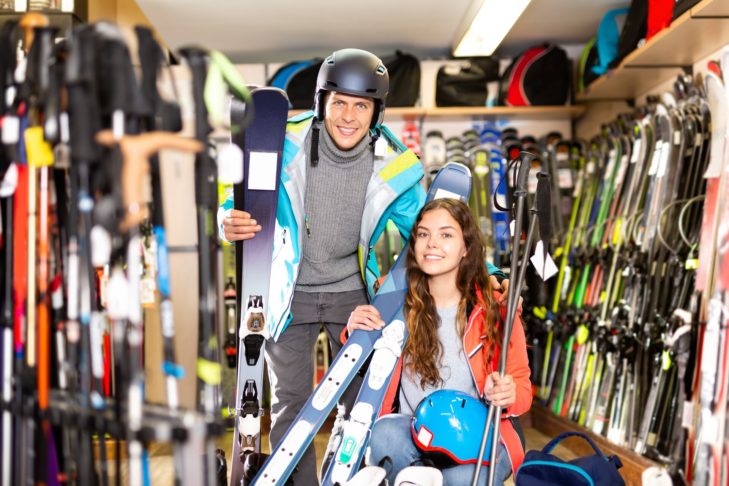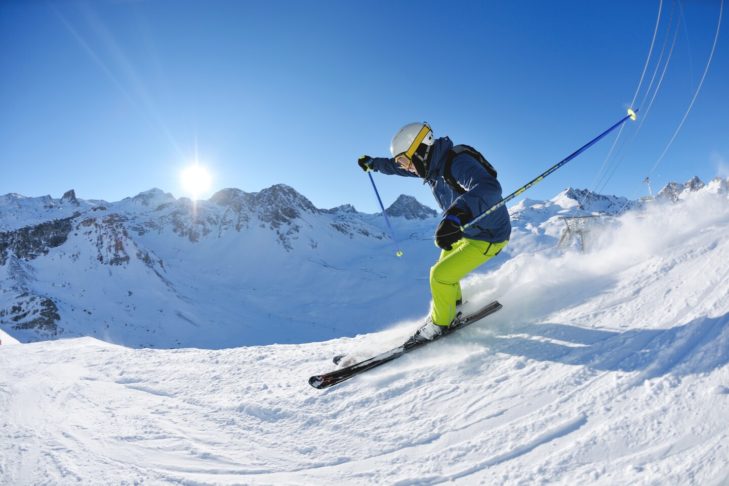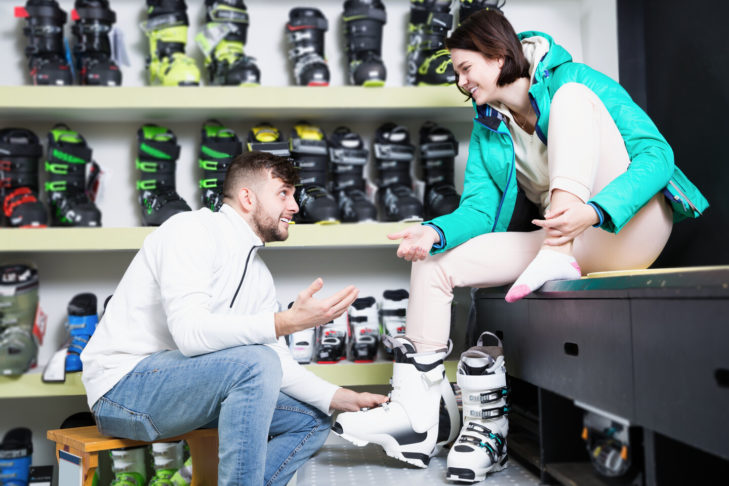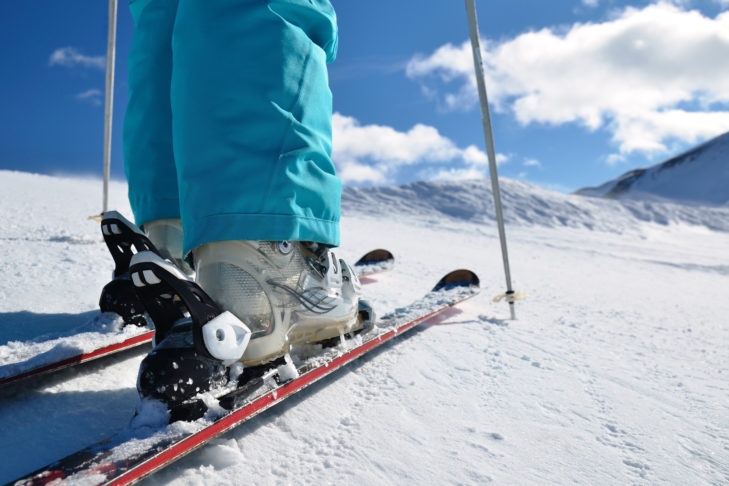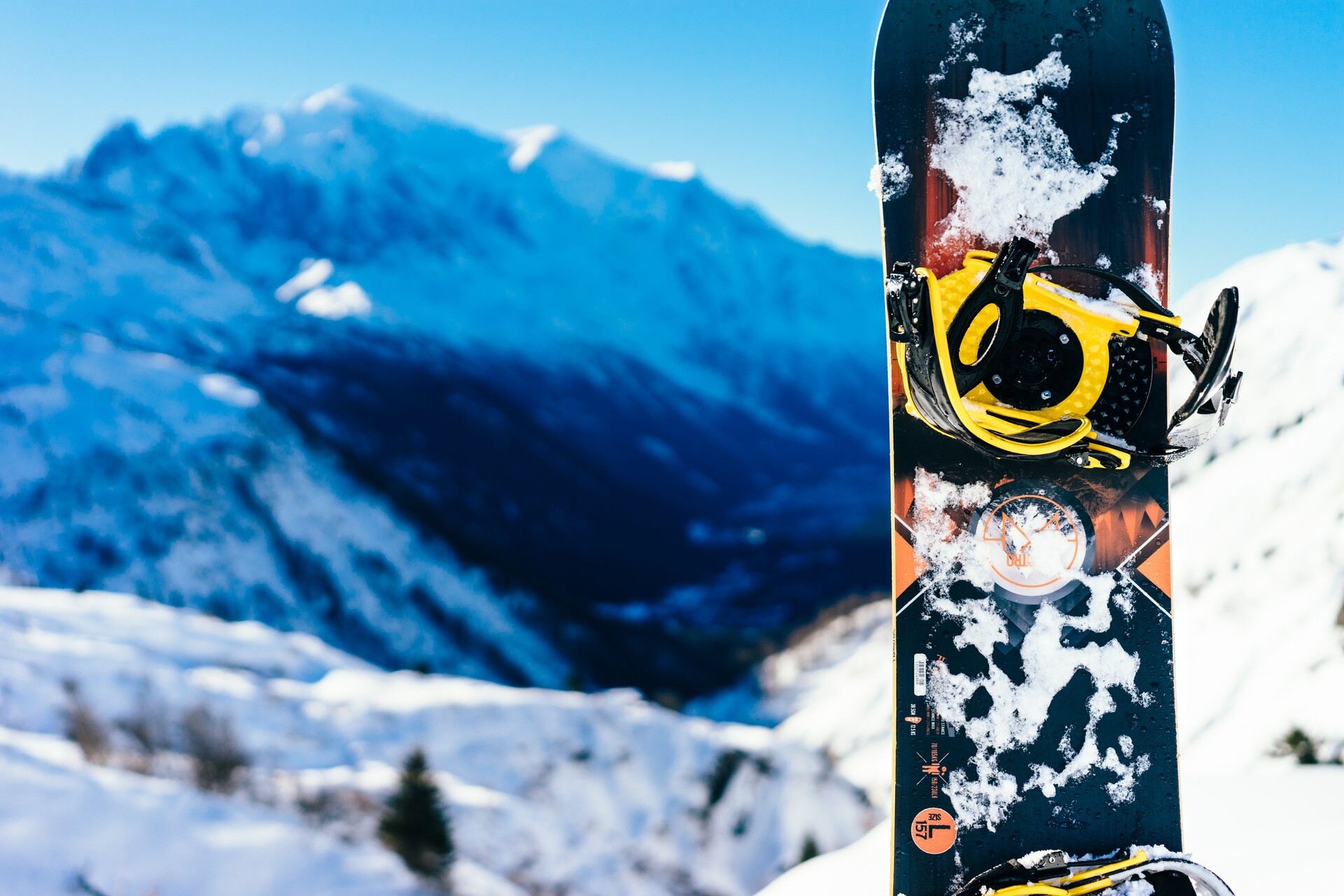Winter sports enthusiasts looking for the right skis will find them – that much is certain. However, it is also clear that buying skis is not always a quick process. In most cases, many skiers already have a few questions after their initial research: Which ski is the right one for me? Is it better to buy new or second-hand skis? And where is the best place to buy my piste equipment? SnowTrex addresses these questions below and provides 7 tips for buying skis.
1. Deciding on a ski model and ski equipment
Before winter sports enthusiasts consider buying or hiring ski equipment, they should first of all be clear about where in the ski resort they want to use their new skis. In addition, be honest with yourself and realistically assess your own ability in advance. For example, beginners will have little fun battling their way down a perfectly groomed piste on slalom or race carvers. Experienced winter sports enthusiasts or even World Cup athletes, on the other hand, will feel right at home with these two ski models. For beginners, all-round carvers are initially the ski material of choice. With their comfortable skiing characteristics, they are the best option for relaxed days on the piste. Once you have gained confidence in your ski equipment, you may want to switch to all-mountain skis. As the name suggests, these skis are suitable for accurate turns on the piste as well as for cruising in deep snow.
Away from the groomed pistes, advanced skiers can reach for freeride skis with a clear conscience and use them to churn up lots of powder. Touring skis are similarly all-terrain. However, due to their construction and ski bindings, they are not only suitable for downhill skiing. Because without a gondola, but with pure muscle power, they can also be used to ascend the mountain! Much more spectacular, but no less physically challenging, are the days spent in snow parks or halfpipes. Freestyle skis are perfect for innovative tricks and spectacular jumps. Thanks to their curved ends, they can even be skied forwards and backwards without any problems. All ski models can generally be used by men and women, although there is now also a special version for women, the lady ski. They are characterised by the fact that they are slightly lighter and the binding is mounted a little further forward for better control.
| Ski model | Ski level | Terrain |
|---|---|---|
| Allround carvers | Beginners & leisure skiers | Piste |
| All-mountain skis | All types, particularly for good skiers with occasional off-piste runs | Piste & Off-piste |
| Slalom carvers | Experienced skiers with precise technique | Piste |
| Lady skis | Specifically for female skiers | Piste & Off-piste |
| Race carvers | Extremely sporty skiers | Piste |
| Freeride carvers | Deep snow & terrain skiers | Off-Piste |
| Freestyle skis | Snow park & ski trick fans | Piste & Snow park |
| Touring skis | Ski tourers | Off-piste |
2. Research prices before buying skis
In order to protect your wallet a little, it is advisable for winter sports enthusiasts to clarify which equipment is suitable for them before buying skis. The main factors here are where the skis will be used and your own ability. After all, the price of a pair of skis also depends on these two factors. The advantage of this approach is that you will immediately have a much clearer idea of the price range of the skis you want. However, prices can vary greatly depending on the model, manufacturer and year of production. For skis that have been on the market for one or two years, it is worth asking your local specialist shop what the original price was at the time. This allows you to quickly assess the extent to which the price currently on offer – whether locally or online – is realistic or somewhat overpriced for the desired product.
For skis that have been on the market for one or two years, it is worth asking your local specialist shop what the new price was at the time. This allows you to quickly assess the extent to which the current price offered – whether locally or online – is realistic or somewhat overpriced for the desired product.
3. Don’t shy away from used ski equipment
The perfect condition of skis is always the top priority when it comes to equipment. After all, the boards are absolutely crucial for safety when it comes to fast-paced action on the piste. Guaranteed quality in this area is provided first and foremost by brand-new skis from well-known manufacturers. Nevertheless, winter sports enthusiasts who are looking for a bargain in terms of equipment should not shy away from used skis. However, caution is often required with online sellers. Private offers on classified ad portals in particular should always be scrutinised first. With verified online shops that explicitly offer used skis, on the other hand, customers can be sure that the used equipment offered there guarantees a good quality standard.
The same applies to local sports shops and specialist retailers directly in the ski resorts. They regularly buy used ski equipment and then hand it over to their own specialised staff. Before the skis go back on sale, the base, edges and bindings are reconditioned by the experts. This means that the material is almost as good as brand-new material in terms of quality. And usually at a significantly lower purchase price.
4. Online retail scores well when buying skis thanks to large selection
One advantage of the internet is the almost limitless choice when buying skis. Customers can access it at any time of day or night with just a few clicks. However, when faced with such a large selection, winter sports enthusiasts can quickly lose track. That’s why it helps to follow a few rules. When buying skis online, the absolute expertise naturally lies with the manufacturers themselves, who offer their latest products via their own online shops. Here, customers can be sure that they will always be able to purchase the latest equipment. But often at considerable prices. After all, the latest materials and technologies cost money.
Skiers can find slightly cheaper deals at well-known sporting goods chains. In addition to the latest models, their online shops often also offer skis from previous winter seasons. If you are still a little overwhelmed by this abundance of products, you can consult tests from independent consumer organisations and use the results to further narrow down the selection for your own ski purchase. When buying skis online, customers should bear in mind that although there is a large selection and the corresponding ski models are available in almost all sizes, some skis cannot always be dispatched immediately. So if there are longer waiting times, it is advisable to make sure that these do not clash with your dream winter holiday. After all, nothing is more annoying than when your dream skis have just been delivered to your home and the new owner has already arrived at the ski resort.
5. Specialist dealers provide the expertise when buying skis
The range offered by local specialist retailers in the ski resorts is somewhat less extensive. After all, the storage capacities of sports shops that sell not only skis but also other piste equipment such as ski boots, ski clothing or snowboards are finite. Nevertheless, snow fans can be sure that some of the equipment that the retailers offer in their shops is always tailored to the ski resort in question. Against the background of this expertise, family ski resorts with predominantly easy pistes therefore have more beginner-friendly models such as all-round carvers or children’s skis on their shelves. The situation is different in sports shops located in ski resorts that are better known for their difficult slopes or spectacular snow parks. Customers there are likely to be offered predominantly sportier products such as race carvers and freeride skis.
6. Unlimited skiing fun thanks to personalised advice
Without the right ski equipment, the anticipation of a long day on the piste is limited. To prevent this from happening in the first place, the staff in the specialist shops are on hand to offer their customers help and advice when buying skis. During a personal consultation, they can directly rule out skis that don’t suit the ability or the terrain the winter sports enthusiast wants to ski. In addition, during the fitting in the presence of the employee, the points that literally pinch can be addressed immediately. Does the ski boot not fit into the binding? Are the skis perhaps too long after all? Or are there scratches and signs of wear on the newly purchased equipment? For adjustments and complaints, the specialist shops have staff who are immediately available and often have quick solutions at hand with their expertise.
Once customers have decided on a ski after the consultation, many specialist shops in the ski resorts also offer the option of renting the equipment directly on the piste. If the winter sports enthusiast finally decides in favour of the ski after this trial period, the purchase price is reduced by the rental costs that would actually have been incurred during this period. And so, in the end, nothing stands in the way of great skiing fun against a fantastic mountain backdrop.
7. Ski experts ensure safety on site
Safety when skiing is the be-all and end-all for a worry-free day on the piste – for every winter sports enthusiast. In addition to choosing the right skis, the other components of the ski equipment must also fit the skier. Boots and bindings can be adjusted in just a few simple steps. However, if you want to be on the safe side, the ski experts on site in the ski resort are the right people to talk to.
The shop staff can weigh the skier in the shop or measure their feet. With this data, the ski boots and the ski bindings can be optimised for each other. The perfectly adjusted Z-value triggers the binding in an emergency and releases the ski to prevent injuries as far as possible.
Would you rather go snowboarding after all? Then SnowTrex has written down the 7 most important tips for buying a snowboard and a perfect day on the mountain for you.
FAQ’s on buying skis
What do I need to consider before buying skis?
Before winter sports enthusiasts buy a ski, they need to be clear about where they want to ski and whether their ability is suitable. With this knowledge, it is much easier to decide on the right ski model. For example, unlike all-round carvers, race carvers are not suitable for beginners. And freeride skis are nowhere near as comfortable on the piste as all-mountain skis.
Is it worth buying used skis?
In contrast to brand-new skis, used skis are significantly cheaper to buy. If the equipment is purchased on the internet from verified online shops or locally in a specialised shop, buyers can be sure that the ski equipment has been carefully prepared and is basically ‘as good as new’.
What are the advantages of buying skis directly from the ski resort?
There are several advantages to buying skis locally from a specialist shop. Firstly, dealers in the ski resort can offer customers personalised advice and help them choose the right skis. In addition, staff can adapt safety-relevant parts of the ski equipment, such as ski boots and ski bindings, directly to the needs of winter sports enthusiasts.
Is it advisable to buy skis online?
Online shops are unbeatable when it comes to the variety of skis on offer. Without personal advice, this selection can be overwhelming at first glance. In order to gain an overview, customers can research tests on consumer portals, for example. When buying skis online, winter sports enthusiasts should also pay attention to delivery times. This way, they can be sure that the skis will be sent to them on time for the start of their holiday.
How much does a pair of skis cost?
The price of inexpensive skis is usually between 100 and 200 euros. High-quality ski models from well-known manufacturers, on the other hand, cost 400 euros or more.

